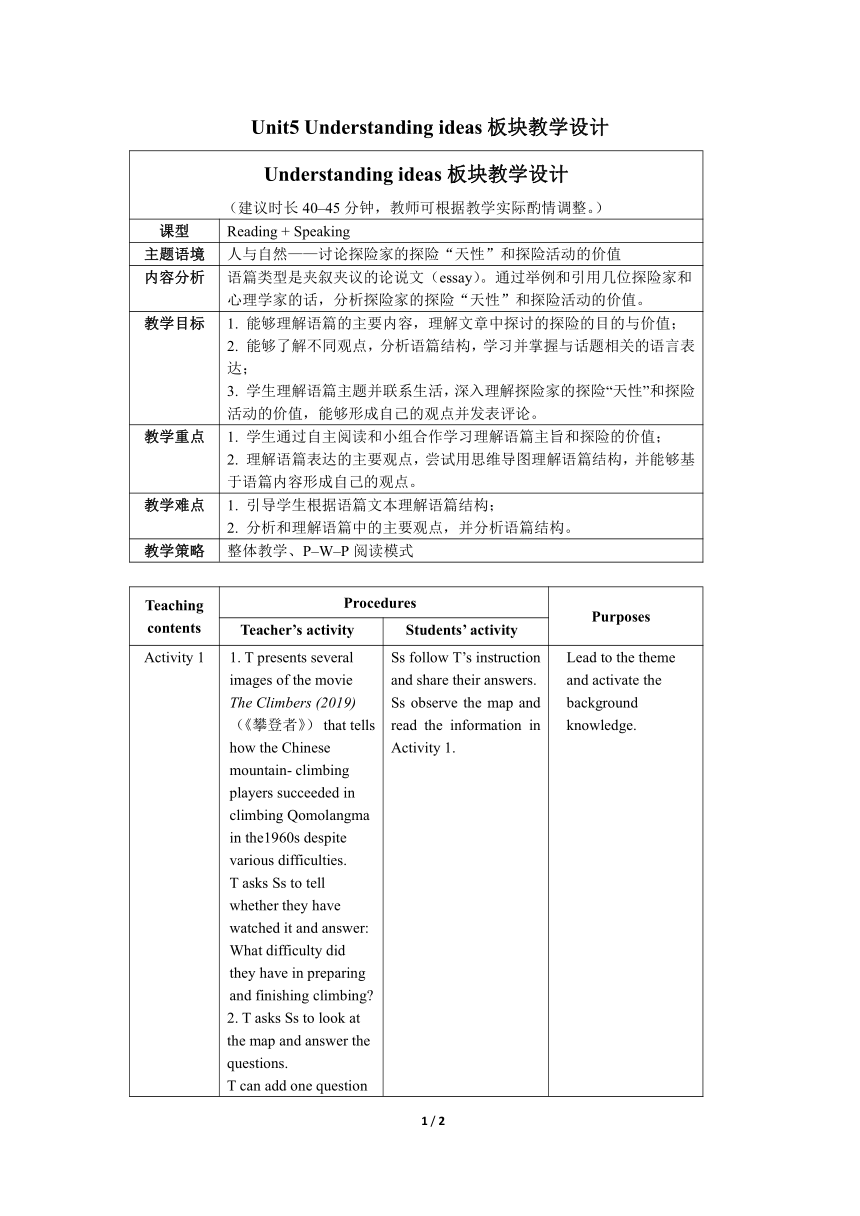外研版(2019)必修第三册 Unit5 What an adventure! Understanding ideas板块教学设计
文档属性
| 名称 | 外研版(2019)必修第三册 Unit5 What an adventure! Understanding ideas板块教学设计 |  | |
| 格式 | docx | ||
| 文件大小 | 21.0KB | ||
| 资源类型 | 教案 | ||
| 版本资源 | 外研版(2019) | ||
| 科目 | 英语 | ||
| 更新时间 | 2023-03-01 17:05:05 | ||
图片预览

文档简介
Unit5 Understanding ideas板块教学设计
Understanding ideas板块教学设计 (建议时长40–45分钟,教师可根据教学实际酌情调整。)
课型 Reading + Speaking
主题语境 人与自然——讨论探险家的探险“天性”和探险活动的价值
内容分析 语篇类型是夹叙夹议的论说文(essay)。通过举例和引用几位探险家和心理学家的话,分析探险家的探险“天性”和探险活动的价值。
教学目标 1. 能够理解语篇的主要内容,理解文章中探讨的探险的目的与价值; 2. 能够了解不同观点,分析语篇结构,学习并掌握与话题相关的语言表达; 3. 学生理解语篇主题并联系生活,深入理解探险家的探险“天性”和探险活动的价值,能够形成自己的观点并发表评论。
教学重点 学生通过自主阅读和小组合作学习理解语篇主旨和探险的价值; 理解语篇表达的主要观点,尝试用思维导图理解语篇结构,并能够基于语篇内容形成自己的观点。
教学难点 引导学生根据语篇文本理解语篇结构; 分析和理解语篇中的主要观点,并分析语篇结构。
教学策略 整体教学、P–W–P阅读模式
Teaching contents Procedures Purposes
Teacher’s activity Students’ activity
Activity 1 1. T presents several images of the movie The Climbers (2019)(《攀登者》) that tells how the Chinese mountain- climbing players succeeded in climbing Qomolangma in the1960s despite various difficulties. T asks Ss to tell whether they have watched it and answer: What difficulty did they have in preparing and finishing climbing 2. T asks Ss to look at the map and answer the questions. T can add one question “Why do some people climb Qomolangma despite the risks ” for Ss to think more about the theme and get ready to explore the passage. Ss follow T’s instruction and share their answers. Ss observe the map and read the information in Activity 1. Lead to the theme and activate the background knowledge.
Activity 2 T asks the Ss to read the passage quickly and find out what “Type T” personalities are. Ss fast read the passage and find the required information. Train students’ reading skill in locating the specific information.
Activity 3 1. T asks Ss to choose the author’s purpose in writing the passage in Activity 3. 2. T asks some Ss to share their answers. 1. Ss complete Activity 3 based on fast reading. They can scan the passage again if necessary. 2. Ss share their answers. Train students’ reading skill in understanding the author’s purpose.
Activity 4 1. T asks Ss to complete the paragraphs with expressions from the passage in Activity 4. 2. T may demonstrate by filling in the first blank. 3. T asks Ss to complete the table in Activity 4. 4. T can continue to inspire Ss to further read the passage and analyse how it is organised. Try drawing a mind map of the organisation of the passage. 1. Ss complete the table in Activity 4 based on the passage. 2. Ss read the passage again, find the right expressions and complete the table. 3. Ss follow T’s instruction and think more deeply about how the passage is organised and try to work out a mind map of the passage. Train Ss’ skill in getting specific information and better understanding the language of the passage. Train Ss’ skill in understanding passage organization and drawing a mind map, helping them better comprehend the passage.
Think & Share T asks Ss to discuss the two questions in groups and offers help when necessary. Ss discuss the two questions in groups and then share with the class. Encourage Ss to think and practise solving similar problems in a real-life situation by employing what they have learned in the passage.
1 / 2
Understanding ideas板块教学设计 (建议时长40–45分钟,教师可根据教学实际酌情调整。)
课型 Reading + Speaking
主题语境 人与自然——讨论探险家的探险“天性”和探险活动的价值
内容分析 语篇类型是夹叙夹议的论说文(essay)。通过举例和引用几位探险家和心理学家的话,分析探险家的探险“天性”和探险活动的价值。
教学目标 1. 能够理解语篇的主要内容,理解文章中探讨的探险的目的与价值; 2. 能够了解不同观点,分析语篇结构,学习并掌握与话题相关的语言表达; 3. 学生理解语篇主题并联系生活,深入理解探险家的探险“天性”和探险活动的价值,能够形成自己的观点并发表评论。
教学重点 学生通过自主阅读和小组合作学习理解语篇主旨和探险的价值; 理解语篇表达的主要观点,尝试用思维导图理解语篇结构,并能够基于语篇内容形成自己的观点。
教学难点 引导学生根据语篇文本理解语篇结构; 分析和理解语篇中的主要观点,并分析语篇结构。
教学策略 整体教学、P–W–P阅读模式
Teaching contents Procedures Purposes
Teacher’s activity Students’ activity
Activity 1 1. T presents several images of the movie The Climbers (2019)(《攀登者》) that tells how the Chinese mountain- climbing players succeeded in climbing Qomolangma in the1960s despite various difficulties. T asks Ss to tell whether they have watched it and answer: What difficulty did they have in preparing and finishing climbing 2. T asks Ss to look at the map and answer the questions. T can add one question “Why do some people climb Qomolangma despite the risks ” for Ss to think more about the theme and get ready to explore the passage. Ss follow T’s instruction and share their answers. Ss observe the map and read the information in Activity 1. Lead to the theme and activate the background knowledge.
Activity 2 T asks the Ss to read the passage quickly and find out what “Type T” personalities are. Ss fast read the passage and find the required information. Train students’ reading skill in locating the specific information.
Activity 3 1. T asks Ss to choose the author’s purpose in writing the passage in Activity 3. 2. T asks some Ss to share their answers. 1. Ss complete Activity 3 based on fast reading. They can scan the passage again if necessary. 2. Ss share their answers. Train students’ reading skill in understanding the author’s purpose.
Activity 4 1. T asks Ss to complete the paragraphs with expressions from the passage in Activity 4. 2. T may demonstrate by filling in the first blank. 3. T asks Ss to complete the table in Activity 4. 4. T can continue to inspire Ss to further read the passage and analyse how it is organised. Try drawing a mind map of the organisation of the passage. 1. Ss complete the table in Activity 4 based on the passage. 2. Ss read the passage again, find the right expressions and complete the table. 3. Ss follow T’s instruction and think more deeply about how the passage is organised and try to work out a mind map of the passage. Train Ss’ skill in getting specific information and better understanding the language of the passage. Train Ss’ skill in understanding passage organization and drawing a mind map, helping them better comprehend the passage.
Think & Share T asks Ss to discuss the two questions in groups and offers help when necessary. Ss discuss the two questions in groups and then share with the class. Encourage Ss to think and practise solving similar problems in a real-life situation by employing what they have learned in the passage.
1 / 2
